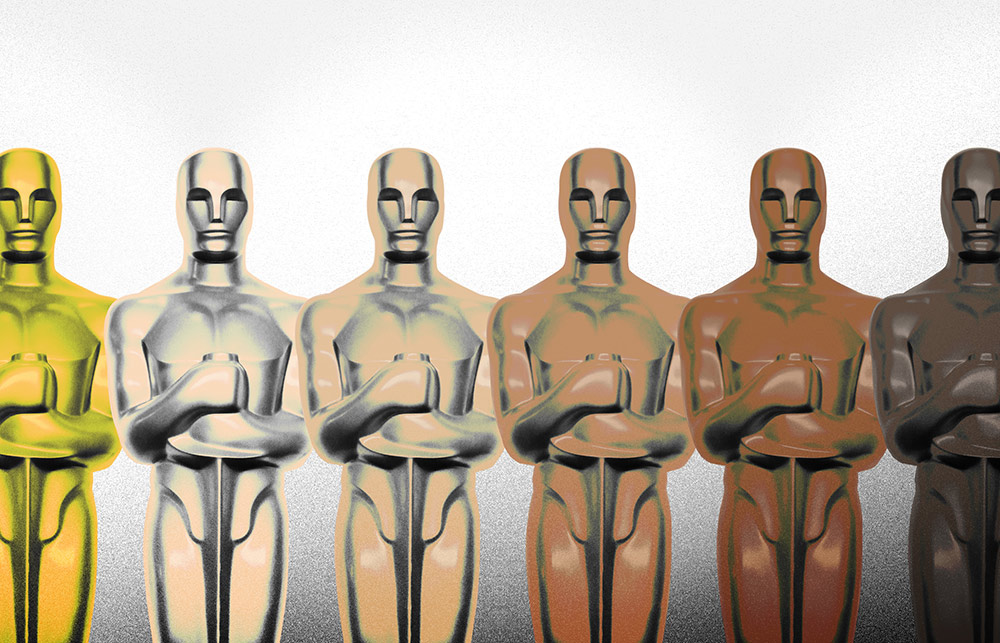今年的奥斯卡提名不再“白人至上”,但平权之路依然任重道远

近年来,多元性、公平性和包容性问题已经成为好莱坞关注的焦点。一些社会组织——例如亚太娱乐联盟(Coalition of Asian Pacifics in Entertainment)和吉娜·戴维斯媒体性别研究所(Geena Davis Institute on Gender in Media)等也一直站在平权前线发声,要求更公平的代表权。
但以前的奥斯卡奖并非如此。实际上,在2015年的奥斯卡几类主要奖项中,仅有两部由少数族裔(BIPOC,即黑人、印第安人、有色人种)电影人制作的影片获得了提名。这让人们纷纷开始传播“奥斯卡奖太白了”(#OscarsSoWhite)的话题,批评该奖项缺乏多元性。
六年后,奥斯卡奖在提名的包容性方面取得了长足的进步。但是,如果该奖项想要更准确地反映其受众的多样性,就依然有很多改进的余地。
今年的提名可能反映了奥斯卡的评审机构(即美国电影艺术与科学学院)终于做出了更加多元化的选择。两名女性首次获得最佳导演提名:《无依之地》(Nomadland)的导演赵婷和《前程似锦的女孩》(Promising Young Woman)的导演埃默拉尔德·芬内尔。史蒂文·元凭借《米纳里》(Minari)中的雅各布一角,成为首位获得奥斯卡最佳男主角提名的亚裔美国人。和他一起创造历史的还有巴基斯坦裔的英国演员里兹·阿迈德——凭借《金属之声》(Sound of Metal)中的表演,他成为历史上第一位获得最佳男主角提名的穆斯林。获得最佳影片提名的《犹大和黑弥赛亚》(Judas and the Black Messiah)则是该奖项中首部完全由黑人团队制作的电影。
在“奥斯卡太白了”的抗议之后,该学院还对终身投票权做出调整,增加了新的管理席位,并重组了委员会。他们在2016年设定的目标是:到2020年,女性和少数族裔成员的数量要增加一倍。奥斯卡奖成员和管理委员会主席杨燕子(Janet Yang)表示,该机构已经实现了少数族裔成员数量的目标,并已经接近实现女性成员数量达到里程碑式级别的目标。
此外,为了帮助电影界少数族裔的“明日之星”,学院也做出了可圈可点的工作。 2017年,它推出了一个“奥斯卡奖金色大师计划”(Academy Gold),面向那些严重缺乏多元性的地方的学生和年轻从业者,旨在为他们在娱乐行业中谋得更好的实习机会和指导。
最后,作为“奥斯卡之光2025”计划(Academy’s Aperture 2025)的一部分,美国电影艺术与科学学院在2020年宣布了有关奥斯卡奖入选资格和标准的新规定。该倡议并非完美无瑕,但是出台新的编纂标准这一行为表明,学院正在走向多元化、公平和包容性方面积极努力,而不只是停留在喊口号层面,并且承认了自己在过去确实以白人男性为中心。
但是,在该学院成立伊始,就是白人(2015年占92%)和男性(占75%)主导,整个组织在这方面的进步也很缓慢。即便他们目前还在吸纳身份更加多元化的新成员,该学院也永远无法代表所有美国人口,因为其新的组织中平均有46%的女性和31%的有色人种,而美国全体人口中有50.5%的女性和39.6%的有色人种。
截至2020年,美国电影艺术与科学学院的成员仍然是84%的白人和68%的男性,他们的平均年龄为62岁。因此,年老的白人仍然在电影业中拥有绝对权威。尽管学院里的女性比过去要多得多,但她们都来自好莱坞那些女性占比已经很高的工作,例如服装设计师(83%)、选角导演(83%)和市场营销或公关从业者(63%)。
学院的多样性举措值得称赞,但希望它不会因此而骄傲自满,它还要继续扩大边缘群体的声音。要知道,刻板印象式的媒介呈现会影响到现实世界。研究表明,如果电视上的黑人角色一直做出很多非语言的负面行为,就会在无形中加深观众的种族偏见。另一项研究发现,看电视会伤害黑人男孩和女孩,以及白人女孩的自尊心。
但是通过为平权运动做出切实的努力、给予这一问题更多关注、各方协同合作,我们就可以带来真正的改变。一项研究发现,每周都和非裔和华裔接触的小学生更愿意去和不同种族的孩子互动。
电影业界和学界在道义上的责任是讲故事——讲的是能够准确反映出观众在日常生活中细微差别的故事。如果觉得这种道义上的理由没有说服力,就不妨从生意经上考虑。
“真正以亚太地区为背景的故事有十分旺盛的市场。”学院成员杨燕子创办了非营利组织Gold House,旨在亚太地区的创业者和企业领导人提供职业生涯支持。
根据我们学者和创作者中心(Center for Scholars & Storytellers)以及麦肯锡(McKinsey)新发布的一份报告中的数据,制作具有包容性的多元文化内容不仅可以给亚太电影界带来切实可观的经济利益,还能够对整个行业的少数族裔都很有利。在这一点上,我们希望学院和整个好莱坞都可以考虑一下他们的道义责任,并为提高多样性和包容性的行动提供经济上的支持,以做出实质性的改变。(财富中文网)
杰里米·兴(Jeremy Hsing)是加州大学洛杉矶分校(UCLA)的学生,也是学者与创作者中心的研究助理。
亚尔达·乌尔斯(Yalda T. Uhls)是学者与创作者中心的创始人。
编译:陈聪聪
近年来,多元性、公平性和包容性问题已经成为好莱坞关注的焦点。一些社会组织——例如亚太娱乐联盟(Coalition of Asian Pacifics in Entertainment)和吉娜·戴维斯媒体性别研究所(Geena Davis Institute on Gender in Media)等也一直站在平权前线发声,要求更公平的代表权。
但以前的奥斯卡奖并非如此。实际上,在2015年的奥斯卡几类主要奖项中,仅有两部由少数族裔(BIPOC,即黑人、印第安人、有色人种)电影人制作的影片获得了提名。这让人们纷纷开始传播“奥斯卡奖太白了”(#OscarsSoWhite)的话题,批评该奖项缺乏多元性。
六年后,奥斯卡奖在提名的包容性方面取得了长足的进步。但是,如果该奖项想要更准确地反映其受众的多样性,就依然有很多改进的余地。
今年的提名可能反映了奥斯卡的评审机构(即美国电影艺术与科学学院)终于做出了更加多元化的选择。两名女性首次获得最佳导演提名:《无依之地》(Nomadland)的导演赵婷和《前程似锦的女孩》(Promising Young Woman)的导演埃默拉尔德·芬内尔。史蒂文·元凭借《米纳里》(Minari)中的雅各布一角,成为首位获得奥斯卡最佳男主角提名的亚裔美国人。和他一起创造历史的还有巴基斯坦裔的英国演员里兹·阿迈德——凭借《金属之声》(Sound of Metal)中的表演,他成为历史上第一位获得最佳男主角提名的穆斯林。获得最佳影片提名的《犹大和黑弥赛亚》(Judas and the Black Messiah)则是该奖项中首部完全由黑人团队制作的电影。
在“奥斯卡太白了”的抗议之后,该学院还对终身投票权做出调整,增加了新的管理席位,并重组了委员会。他们在2016年设定的目标是:到2020年,女性和少数族裔成员的数量要增加一倍。奥斯卡奖成员和管理委员会主席杨燕子(Janet Yang)表示,该机构已经实现了少数族裔成员数量的目标,并已经接近实现女性成员数量达到里程碑式级别的目标。
此外,为了帮助电影界少数族裔的“明日之星”,学院也做出了可圈可点的工作。 2017年,它推出了一个“奥斯卡奖金色大师计划”(Academy Gold),面向那些严重缺乏多元性的地方的学生和年轻从业者,旨在为他们在娱乐行业中谋得更好的实习机会和指导。
最后,作为“奥斯卡之光2025”计划(Academy’s Aperture 2025)的一部分,美国电影艺术与科学学院在2020年宣布了有关奥斯卡奖入选资格和标准的新规定。该倡议并非完美无瑕,但是出台新的编纂标准这一行为表明,学院正在走向多元化、公平和包容性方面积极努力,而不只是停留在喊口号层面,并且承认了自己在过去确实以白人男性为中心。
但是,在该学院成立伊始,就是白人(2015年占92%)和男性(占75%)主导,整个组织在这方面的进步也很缓慢。即便他们目前还在吸纳身份更加多元化的新成员,该学院也永远无法代表所有美国人口,因为其新的组织中平均有46%的女性和31%的有色人种,而美国全体人口中有50.5%的女性和39.6%的有色人种。
截至2020年,美国电影艺术与科学学院的成员仍然是84%的白人和68%的男性,他们的平均年龄为62岁。因此,年老的白人仍然在电影业中拥有绝对权威。尽管学院里的女性比过去要多得多,但她们都来自好莱坞那些女性占比已经很高的工作,例如服装设计师(83%)、选角导演(83%)和市场营销或公关从业者(63%)。
学院的多样性举措值得称赞,但希望它不会因此而骄傲自满,它还要继续扩大边缘群体的声音。要知道,刻板印象式的媒介呈现会影响到现实世界。研究表明,如果电视上的黑人角色一直做出很多非语言的负面行为,就会在无形中加深观众的种族偏见。另一项研究发现,看电视会伤害黑人男孩和女孩,以及白人女孩的自尊心。
但是通过为平权运动做出切实的努力、给予这一问题更多关注、各方协同合作,我们就可以带来真正的改变。一项研究发现,每周都和非裔和华裔接触的小学生更愿意去和不同种族的孩子互动。
电影业界和学界在道义上的责任是讲故事——讲的是能够准确反映出观众在日常生活中细微差别的故事。如果觉得这种道义上的理由没有说服力,就不妨从生意经上考虑。
“真正以亚太地区为背景的故事有十分旺盛的市场。”学院成员杨燕子创办了非营利组织Gold House,旨在亚太地区的创业者和企业领导人提供职业生涯支持。
根据我们学者和创作者中心(Center for Scholars & Storytellers)以及麦肯锡(McKinsey)新发布的一份报告中的数据,制作具有包容性的多元文化内容不仅可以给亚太电影界带来切实可观的经济利益,还能够对整个行业的少数族裔都很有利。在这一点上,我们希望学院和整个好莱坞都可以考虑一下他们的道义责任,并为提高多样性和包容性的行动提供经济上的支持,以做出实质性的改变。(财富中文网)
杰里米·兴(Jeremy Hsing)是加州大学洛杉矶分校(UCLA)的学生,也是学者与创作者中心的研究助理。
亚尔达·乌尔斯(Yalda T. Uhls)是学者与创作者中心的创始人。
编译:陈聪聪
In the past few years, diversity, equity, and inclusion has become a front-and-center issue for Hollywood. Organizations such as the Coalition of Asian Pacifics in Entertainment and the Geena Davis Institute on Gender in Media have been leading the way in demanding more equitable representation.
But it wasn’t always that way. In fact, in 2015, only two movies by a Black, Indigenous, or person of color (BIPOC) filmmaker were nominated in major categories at the Oscars. This led to the trending hashtag #OscarsSoWhite, created to call out the Academy for its lack of diversity.
Six years later, the Academy has come a long way in becoming more inclusive in its nominations. However, there is still much room for improvement if the Academy wants to accurately reflect the diversity of its viewership.
This year’s nominations may finally reflect the choices of a more diverse Academy membership. Two women are nominated for best director for the first time ever: Chloé Zhao (Nomadland) and Emerald Fennell (Promising Young Woman). Steven Yeun is the first Asian American ever nominated for the best actor Oscar for his performance as Jacob in Minari. He is joined by the British-Pakistani actor Riz Ahmed, who made history becoming the first Muslim nominated for best actor in Sound of Metal. And Judas and the Black Messiah has the first all-Black production team to be nominated for best picture.
After #OscarsSoWhite, the Academy reframed lifetime voting rights, added new governor seats, and restructured committees. Its goal in 2016 was to double the number of women and BIPOC members by 2020. Janet Yang, chair of the membership and governance committee at the Academy, told us that the institution has met its goal for BIPOC and is close to meeting the milestone for women.
Moreover, the Academy has done an admirable job to help the BIPOC filmmakers of tomorrow. In 2017, it created Academy Gold, an entertainment industry–wide internship enhancement and mentorship program for students and young professionals from underrepresented communities.
Lastly, in 2020 the Academy announced new representation and inclusion standards for Oscars eligibility as part of its Academy Aperture 2025 initiative. The initiative isn’t perfect, but the act of codifying standards shows the Academy’s positive trajectory toward diversity, equity, and inclusion beyond tokenism, as well as its acknowledgement of its white male–centric past.
However, the organization began from a place of such whiteness (92% in 2015) and maleness (75%) that its overall composition is evolving slowly. Even if the group continues to invite members at this current, far more inclusive rate, the Academy would never be representative of the U.S. population, because its new classes have averaged 46% female and 31% people of color, while the U.S. overall is 50.5% female and 39.6% people of color.
As of 2020, Academy membership was still 84% white and 68% male, and the average age of an Academy member was 62. Thus, older white men still hold the positions of power and influence in the film industry. And while the Academy’s female numbers are much larger than in the past, they are drawn from Hollywood jobs that already have heavy female representation, such as costume designers (83%), casting directors (83%), and marketing or PR professionals (63%).
The Academy deserves credit for its diversity initiatives, but hopefully it will not become complacent and will continue to amplify the voices of marginalized communities. Stereotypical representation has real-world implications. Research shows that watching TV characters express negative nonverbal behavior toward Black characters increases viewers’ unconscious race bias. Another study found that watching TV decreased the self-esteem of Black boys and girls and white girls.
But with work, attention, and collaboration, we can make a real difference. One study found that elementary school children exposed to weekly stories featuring African and Chinese characters were more interested in interacting with children different from their own race.
It is the moral responsibility of filmmakers and scholars to tell stories that accurately reflect the everyday nuances of their audiences. But if the moral argument doesn’t sway you, then consider the business imperative.
“There is a robust market for authentic AAPI [Asian American and Pacific Islander] stories,” said Academy member Yang, who cofounded Gold House, a nonprofit supporting the careers of AAPI founders and leaders.
Data released by our organization, the Center for Scholars & Storytellers, and a newly published McKinsey report indicate that making inclusive multicultural content isn’t just financially beneficial for the AAPI filmmaking community, but all BIPOC in the industry. With this in mind, our hope is for the Academy and Hollywood at large to consider both their morality as well as the financial upside of implementing substantial changes with regard to diversity and inclusion.
Jeremy Hsing is a student at UCLA and a research assistant at the Center for Scholars & Storytellers.
Yalda T. Uhls is the founding director of the Center for Scholars & Storytellers.













